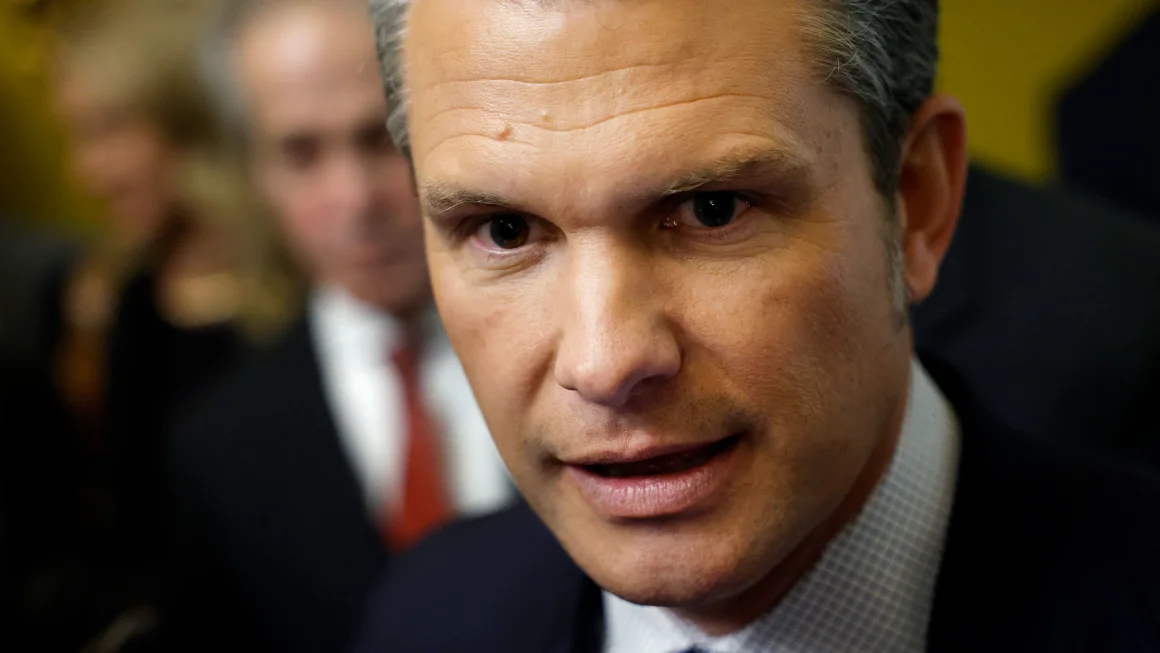
Sure, there’s intensity in many other high-profile games. There’s pomp and circumstance every weekend in college football. There’s history and pride on the line, week-in-and-week-out across the nation.
But there’s nothing like Army-Navy.
From the moment each student body enters the stadium – marching onto the field in formation before heading into the stands – to when each team gathers to sing their alma mater after the game is over, the annual matchup carries a heft that simply does not exist in the rest of college football. While both teams are burning to beat each other, having thought about this game from the moment practices began, there is an underlying level of respect and reverence for each other: future brothers-in-arms clashing for bragging rights that they’ll carry with them for the rest of their lives.
“The military service aspect of it definitely makes it different than any other rivalry,” Army quarterback Bryson Daily told CNN. “You know, the two branches in their long histories, you know, just having that rivalry. And when you go into service together after you get to kind of hold that against them and let them have it for the rest of your careers … you know, it really doesn’t happen any other college sports rivalry.”
“This game represents more than just us, the players,” said Colin Ramos, a linebacker for Navy who’s also a team captain. “It’s all the people that have come before us who have served this country. They’ve sacrificed their lives for this country.”
He added, “It’s unlike any other game where both sides are going to end up serving this country.”
For the 125th time on Saturday, the two service academies will face off in their (mostly) annual showdown at Northwest Stadium in Landover, Maryland, the home of the Washington Commanders, kicking off at 3 p.m. ET on CBS.
With 11-1 Army coming in as American Athletic Conference champions and Navy sitting at 8-3, it’s set to be one of the most high-profile editions of the game in recent years as both service academies are fielding teams that had dreams of a spot in the College Football Playoff at one point in the season and are looking forward to bowl games at the end of the month.
To add to the pomp and circumstance, President-elect Donald Trump is expected to attend the game a little more than a month before he takes the oath of office for his second term.
And when you ask players and coaches from both teams what this game means, one word comes up over and over: “Everything.”
‘The epitome of football’
In many ways, the matchup between Army and Navy is like stepping into a time machine and traveling back to a completely different era of college football.
On the field, the game is primarily fought on the ground at a time when up-tempo, pass-heavy offensive attacks are in vogue across college and professional football. The players themselves are not exactly the massive super athletes that make up the vast majority of major programs’ rosters. It’s a game that is tussled in the trenches of the offensive and defensive lines, in the collisions between offensive backs and linebackers, in the clash of unique play design and defensive intensity.
Off the gridiron, football is far from the most important thing in the lives of either set of players. Each cadet and midshipman is training to become an officer in their service branch and at least five years of military service awaits them. At a time when college football is being reshaped and realigned in the search for big money, for players and schools alike, there are no name, image and likeness (NIL) collectives at either school and the only payment they receive are the stipends that go to every West Point and Naval Academy student.

For the cadets and midshipmen on the field, a career playing professional football is unlikely. This game is their Super Bowl.
“It represents a battle between two of the nation’s best forces, honestly. You know, it’s always the most physical battle of the year. It’s the most intense battle of the year, and that’s what it represents,” said Daba Fofana, a senior fullback for Navy. “It represents the epitome of football.”
There’s a certain current of old-fashioned values that run through the two squads, a level of respect for one another that hasn’t exactly been evident in some of the highest-profile rivalry games this season. November 30, when most of the biggest rivalries in college football were contested, saw a number of ugly scenes when victorious road teams planted their flags on the fields of their rivals – sparking brawls and even some pepper spray being deployed in order to break up the fracas at Ohio Stadium after Michigan beat Ohio State.
While Navy and Army will be opponents on Saturday, in the future they’ll be working together to defend the United States. That bond underlines every part of the game.
“Between the white lines, it’s a football game,” Ramos said. “Of course, there’s a level of respect. We’re not gonna be playing the flags or anything at the end of the game. That’s not us. It’s not the two academies. But ultimately, we’re competitors out there. We’re football players. We love to play football. That’s what we’ll do.”
A game steeped in tradition
First played in 1890 — Navy beat Army, for what it’s worth — and annually since 1930, the rivalry brings its unique traditions each year.
At West Point, Beat Navy week is marked by the burning of a bonfire with a 20-foot effigy of a Navy ship before the Army marathon team begins the 300-mile run from campus to Northwest Stadium to deliver the game ball. They’ll be joined for the final stretch by members of the Navy’s 13th company.
On Friday, members of each academy take part in the Patriot Games that are being held on the National Mall. Midshipmen and cadets will compete in four different competitions and the team that wins the most points will be honored at halftime of the football game on Saturday.
Game day itself is a series of special moments. First, there is the entrance of the Corps of Cadets and the Brigade of Midshipmen, in which the student body from each school marches in formation on the gridiron before taking their seats in the stands.

The schools also hold their “prisoner exchange.” Students from West Point and the Naval Academy who are attending classes at their rival institution in order to begin training in joint command operations are brought to midfield and then allowed to join their home institution comrades for the entirety of the game, allowing them to cheer on their fellow students in the comfort of friendly surroundings.
Each service traditionally gets the chance to show off its air power with pregame flyovers that put the US military’s might on full display. Traditionally, the US president conducts the pregame coin toss, when in attendance, as the ultimate impartial observer. It’s unknown if Trump, as president-elect, will take up the honor at this year’s game.
After the final whistle blows, both teams join together to sing one another’s alma mater to close the day.
“It’s surreal and I always take just a few minutes before the game just to kind of take that all in,” said Navy head coach Brian Newberry. “Just extremely grateful to be a part of it. It’s a privilege and an honor. (I’m) extremely grateful to be the head coach at the Naval Academy for what it represents to lead these young men on the field. So, it’s a great privilege.”
A special year for a special game
In this year’s 125th edition of the game, there’s an added level of distinction placed on top of the usual pomp.
Both teams will be wearing special uniforms: Army is honoring the 101st Airborne Division’s heroics in the siege of Bastogne 80 years ago while Navy is honoring Strike Fighter Squadron (VFA) 103 with their Jolly Rogers-themed kit.
“I absolutely love it, like they’re one of the best uniforms I’ve had since I’ve been here,” Fofana said of the Jolly Rogers. “And it just, what we’re representing is it’s, it’s awesome, it’s awesome. It’s absolutely a blessing to even wear that.”
On the Bastogne uniforms, Daily said, “Oh, they’re incredible. I think they did a great job. You know, it represents a great moment in the Army’s history. Some incredible men fought in that unit, in that battle. So it’s awesome that we get to represent them. And if we can be, you know, half as tough and courageous as those guys then we’ll have success on the field.”
The game will also decide the winner of the Commander-in-Chief Trophy, which goes to the service academy with the best record in their two rivalry games. Both Army and Navy have beaten the Air Force Academy already this season, which guarantees that the winner of this game will take home the trophy and get the opportunity to visit the White House and meet the president later on.
Army has won three of the last four Army-Navy games and has won at least a share of the Commander-in-Chief Trophy in three of the last four years as well. It’s a fact that weighs heavy on the minds of seniors like Ramos and Fofana, who are looking to win the trophy for the first time before they leave the academy.

“This game means everything to me, especially this year not having won a CIC since I’ve been here and we’re in a position to do it,” Fofana said. “It means a ton to just be able to have the opportunity to do that, even just for my brothers, because … the love I have for them, they deserve a CIC.”
“Being here four years, we beat them up my freshman year. We lost the last two years. We want to go out the right way and we want a great game,” Ramos added.
But Daily and the Black Knights are not exactly going to hand over the trophy. Coming into the game with a ton of confidence, the school’s first conference championship and looking for the first 12-win season in school history, returning the Army football program to glory has been a point of emphasis for the West Point Class of 2025.
“That was personal as a class,” he said, “and we wanted to, you know, right the ship and get back to the winning ways. So, it was very personal in the offseason, and, you know, all season, just kind of getting Army football back to where it needed to be.”


